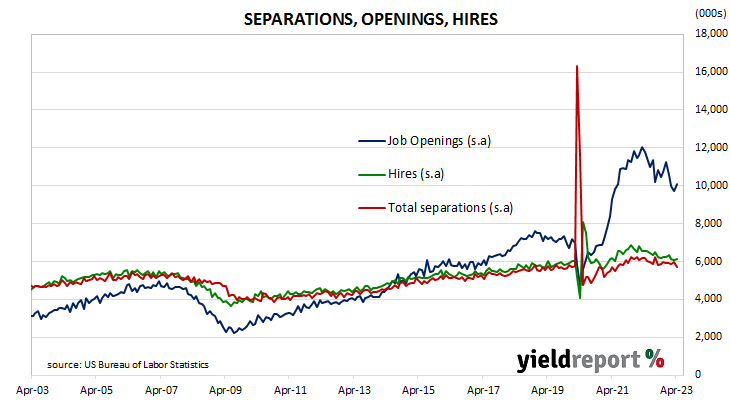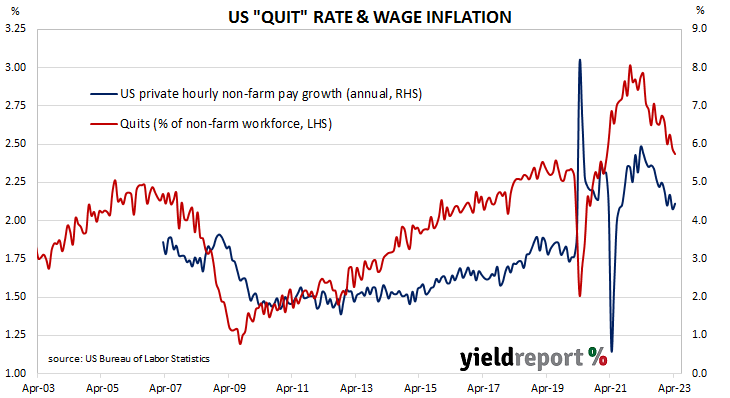Summary: US quit rate falls to 2.4% in April; ANZ: supports picture of robust US jobs market; US Treasury yields down; expectations of lower Fed rates in 2024 firm; quits, separations down, openings up; NAB: some hints of looser labour market.
The number of US employees who quit their jobs as a percentage of total employment increased slowly but steadily after the GFC. It peaked in March 2019 and then tracked sideways until virus containment measures were introduced in March 2020. The quit rate then plummeted as alternative employment opportunities rapidly dried up. Following the easing of US pandemic restrictions, it proceeded to recover back to its pre-pandemic rate in the third quarter of 2020 and trended higher through 2021 before easing through 2022 and early 2023.
Figures released as part of the latest Job Openings and Labor Turnover Survey (JOLTS) report show the quit rate declined for a second consecutive month in April. 2.4% of the non-farm workforce left their jobs voluntarily, down from 2.5% in March. Quits in the month fell by 49,000 while an additional 253,000 people were employed in non-farm sectors.
“Quits, which are voluntary separations and are often seen as a barometer of worker confidence in the labour market, eased a negligible 49,000 to 3.793 million, supporting the picture of a robust jobs market,” said ANZ economist Madeline Dunk.
US Treasury yields moved lower on the day. By the close of business, the 2-year had shed 9bps to 4.37% while 10-year and 30-year yields both finished 5bps lower at 3.64% and 3.84% respectively.
In terms of US Fed policy, expectations of lower federal funds rates in 2024 firmed. At the close of business, contracts implied the effective federal funds rate would average 5.125% in June, 5bps higher than the current spot rate, and then move up to average 5.18% in July. September futures contracts implied a 5.27% average effective federal funds rate while May 2024 contracts implied 4.255%, 83bps less than the current rate.
The fall in total quits was led by 178,000 fewer resignations in the “Health care and social assistance” sector while the “Wholesale trade” sector experienced the largest gain, increasing by 29,000. Overall, the total number of quits for the month fell from March’s revised figure of 3.842 million to 3.793 million.
Ken Crompton, a senior interest rate strategist at NAB, took a somewhat less positive view of the figures than that of ANZ’s Dunk. “Although openings to applicants hit a three-month high, the quit rate has slipped to a two-year low so there are some hints of a looser labour market.“
Total vacancies at the end of April increased by 0.358 million, or 3.7%, from March’s revised figure of 9.745 million to 10.103 million. The rise was driven by a 209,000 gain in the “Retail trade” sector while the “Accommodation and food services” sector experienced the single largest decrease, falling by 80,000. Overall, 8 out of 18 sectors experienced more job openings than in the previous month.
Total separations decreased by 286,000, or 4.8%, from March’s revised figure of 5.994 million to 5.708 million. The fall was led by the “Construction” sector where there were 83,000 fewer separations than in March. Separations decreased in 11 of the 18 sectors.

The “quit” rate time series produced by the JOLTS report is a leading indicator of US hourly pay. As wages account for around 55% of a product’s or service’s price in the US, wage inflation and overall inflation rates tend to be closely related. Former Federal Reserve chief and current Treasury Secretary Janet Yellen was known to pay close attention to it.


